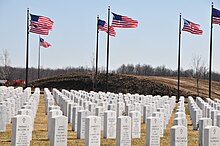Bay County

- Fletcher Site in Bay City; a Native American cemetery and archaeological site
This list of cemeteries in Michigan includes currently operating, historical (closed for new interments), and defunct (graves abandoned or removed) cemeteries, columbaria, and mausolea which are historical and/or notable. It does not include pet cemeteries.

| | This section is empty. You can help by adding to it. (February 2025) |


| | This section is empty. You can help by adding to it. (February 2025) |


